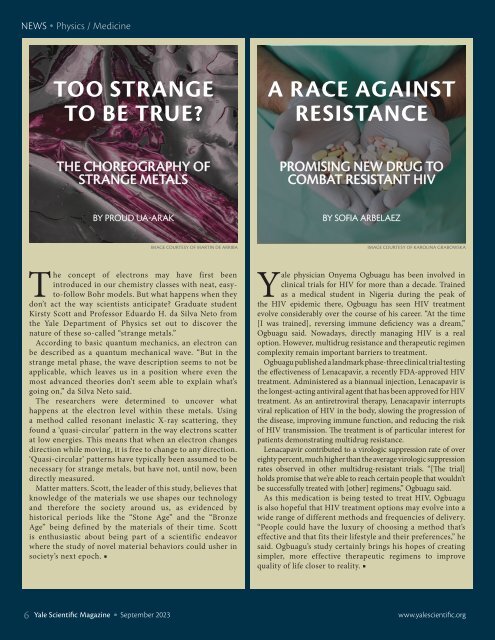YSM Issue 96.3
You also want an ePaper? Increase the reach of your titles
YUMPU automatically turns print PDFs into web optimized ePapers that Google loves.
NEWS<br />
Physics / Medicine<br />
TOO STRANGE<br />
TO BE TRUE?<br />
A RACE AGAINST<br />
RESISTANCE<br />
THE CHOREOGRAPHY OF<br />
STRANGE METALS<br />
PROMISING NEW DRUG TO<br />
COMBAT RESISTANT HIV<br />
BY PROUD UA-ARAK<br />
BY SOFIA ARBELAEZ<br />
IMAGE COURTESY OF MARTIN DE ARRIBA<br />
IMAGE COURTESY OF KAROLINA GRABOWSKA<br />
The concept of electrons may have first been<br />
introduced in our chemistry classes with neat, easyto-follow<br />
Bohr models. But what happens when they<br />
don’t act the way scientists anticipate? Graduate student<br />
Kirsty Scott and Professor Eduardo H. da Silva Neto from<br />
the Yale Department of Physics set out to discover the<br />
nature of these so-called “strange metals.”<br />
According to basic quantum mechanics, an electron can<br />
be described as a quantum mechanical wave. “But in the<br />
strange metal phase, the wave description seems to not be<br />
applicable, which leaves us in a position where even the<br />
most advanced theories don’t seem able to explain what’s<br />
going on,” da Silva Neto said.<br />
The researchers were determined to uncover what<br />
happens at the electron level within these metals. Using<br />
a method called resonant inelastic X-ray scattering, they<br />
found a ‘quasi-circular’ pattern in the way electrons scatter<br />
at low energies. This means that when an electron changes<br />
direction while moving, it is free to change to any direction.<br />
‘Quasi-circular’ patterns have typically been assumed to be<br />
necessary for strange metals, but have not, until now, been<br />
directly measured.<br />
Matter matters. Scott, the leader of this study, believes that<br />
knowledge of the materials we use shapes our technology<br />
and therefore the society around us, as evidenced by<br />
historical periods like the “Stone Age” and the “Bronze<br />
Age” being defined by the materials of their time. Scott<br />
is enthusiastic about being part of a scientific endeavor<br />
where the study of novel material behaviors could usher in<br />
society’s next epoch. ■<br />
Yale physician Onyema Ogbuagu has been involved in<br />
clinical trials for HIV for more than a decade. Trained<br />
as a medical student in Nigeria during the peak of<br />
the HIV epidemic there, Ogbuagu has seen HIV treatment<br />
evolve considerably over the course of his career. “At the time<br />
[I was trained], reversing immune deficiency was a dream,”<br />
Ogbuagu said. Nowadays, directly managing HIV is a real<br />
option. However, multidrug resistance and therapeutic regimen<br />
complexity remain important barriers to treatment.<br />
Ogbuagu published a landmark phase-three clinical trial testing<br />
the effectiveness of Lenacapavir, a recently FDA-approved HIV<br />
treatment. Administered as a biannual injection, Lenacapavir is<br />
the longest-acting antiviral agent that has been approved for HIV<br />
treatment. As an antiretroviral therapy, Lenacapavir interrupts<br />
viral replication of HIV in the body, slowing the progression of<br />
the disease, improving immune function, and reducing the risk<br />
of HIV transmission. The treatment is of particular interest for<br />
patients demonstrating multidrug resistance.<br />
Lenacapavir contributed to a virologic suppression rate of over<br />
eighty percent, much higher than the average virologic suppression<br />
rates observed in other multidrug-resistant trials. “[The trial]<br />
holds promise that we’re able to reach certain people that wouldn’t<br />
be successfully treated with [other] regimens,” Ogbuagu said.<br />
As this medication is being tested to treat HIV, Ogbuagu<br />
is also hopeful that HIV treatment options may evolve into a<br />
wide range of different methods and frequencies of delivery.<br />
“People could have the luxury of choosing a method that’s<br />
effective and that fits their lifestyle and their preferences,” he<br />
said. Ogbuagu’s study certainly brings his hopes of creating<br />
simpler, more effective therapeutic regimens to improve<br />
quality of life closer to reality. ■<br />
6 Yale Scientific Magazine September 2023 www.yalescientific.org

















